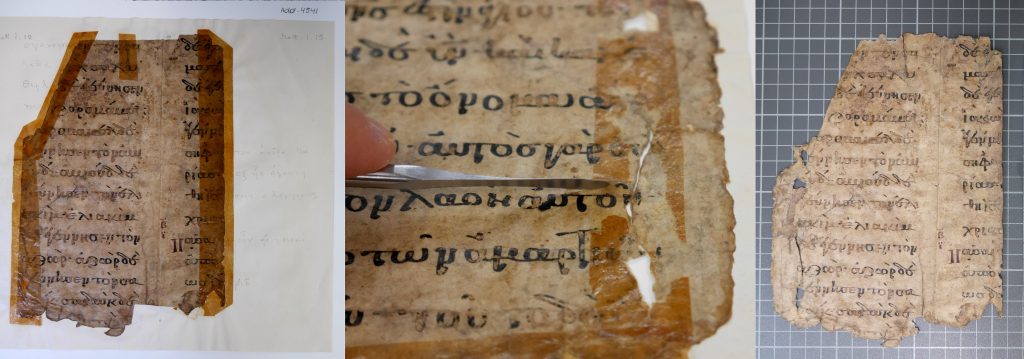
The Polonsky Foundation Greek Manuscripts Project: Conserving fragments
Since the introductory blogpost from conservation on The Polonsky Greek Manuscripts Project, we have made a lot of progress, having completed the survey of the four hundred and forty-four manuscripts involved in the project, and have started treatment. The survey encompassed items from both Cambridge University Library (CUL) and thirteen other Cambridge institutions. The data collected from the survey has been instrumental in identifying at-risk items, designing treatment proposals and planning a workflow. From studying the data collected during the survey it was decided our first step would be to prepare the sixty-eight flat and unbound materials from the CUL for digitisation.
The unbound materials at CUL are incredibly varied; they include items made from paper, parchment and papyrus as well as formats ranging from fragments, single leaves, unbound gatherings and even a wooden board. The manuscripts were housed in a variety of enclosures, such as clamshell boxes, folders and glass, mostly dating from the early 20th century.

Photos during treatment
The first step of treatment involved removing the items from their current enclosures; this might be because the materials used were acidic, degraded or structurally weak. After releasing the items, they were prepared for imaging which involved dry cleaning, stabilising tears and losses, pigment consolidation and removing damaging repairs. One example (as shown below) required dry cleaning using a soft brush and cosmetic sponge, after which the adhesive tape holding the object to a thin card support was removed mechanically with a spatula. This is a lengthy, meticulous and necessary process as the chemically unstable tape posed a high risk of damaging the object in the future.

Tape Removal Treatment
Once stable, the manuscripts were imaged by the Digital Content Unit (DCU). After imaging, the items could be rehoused. Various methods were used, such as Melinex pockets, four-flap folders, pamphlets and mounts. The manuscripts could then be returned to the library shelves and can now be safely consulted by our readers and researchers.

Rehousing Solutions
So, what’s next? We are now looking forward to conserving the bound items, starting with the CUL collection. Three unstable items have also been identified that require more in-depth conservation treatment and we are currently studying those bindings in preparation for treatment.
Alongside conservation treatments, our work on the Medieval Eastern Mediterranean book models is continuing, which you will see in a blogpost soon!
